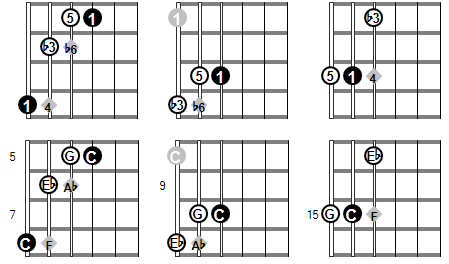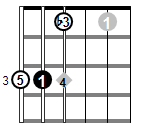Minor Triads
A triad is a simple chord, comprised of the root, the third, and the fifth.
For example, an C Minor triad in root position would be C-E♭-G.
What does it mean to invert a chord? An inversion is when you play all the notes in a triad but don’t play the root note in the bass. A first inversion puts the third in the bass, while a second inversion puts the fifth in the bass.
So an C Minor triad in first inversion would be spelled E♭-G-C, and second inversion would be spelled G-C-E♭.
Let’s use the NANDI method to decode minor triads. Take a look at the fret diagrams below:


Let’s start with root position C minor triad on the 8th fret of the D string. We know that the same fret one string up is a fourth, so we simply move two half-steps down and we’re at our minor third. One fourth up from our minor third brings us to the minor sixth, so we drop one half-step to the fifth. This gives us a C minor triad in root position.
For a first inversion, we can start with E at the 11th fret of our E string. A fourth one string up on the same fret brings us to ♭6. We move one half-step down to the 5 or G. A fourth up on the same fret of the D string brings us back to the root. This is a C minor triad in first inversion.
Finally, our second inversion. Starts on G at the 15th fret of the E string, we move one string up (one fourth up) which brings us to the root. Simple. Then from the root we move up a fourth, and then drop it by two half-steps to reach the minor third.
That is it!
Watch the video below to learn how to visualize the chord tones in a basic minor chord:
How To Find Minor Triad Inversions In CAGED Shapes
Now that we’ve got our major triad inversions down, let’s dig in and learn about minor triad inversions.
To plot a minor triad in root position, the idea is to plot our ♭3 and 5 intervals without going one fret above or one fret below our two fret locations.
Once again, we are going to use the fourth pattern chart.

C Shape – C Minor Triad
Let’s start with the C Shape.

If we want to build a C minor triad in root position, we will find our root on the third fret of the fifth (A) string. From our root, we can move a fourth up on the next string, which is 4. We can then use that 4 as a reference to find our ♭3 two frets down.
Next, we must find the 5 on the next string over. We can once again refer back to our fourth pattern chart to see that ♭6 is a fourth up from our ♭3. Using our ♭6 as a reference, we can locate our 5 one fret down.
Now let’s move on and find our first inversion minor triad.

In this instance, the ♭3 is the lowest note, followed by the 5, then the 1. The fourth down from our ♭3 is ♭6. We can use that ♭6 as a reference to find our 5 one fret down, which in this case is the open string.
Once again, a fourth from 5 is our 1.
Remember, a fourth from any note is always on the same fret on the next string. The only exception is when we are moving from the G to the B string. In that case, you must move one fret up.
Let’s move on to our second inversion minor triad. In a second inversion minor triad, your 5 will be in the bass, followed by the 1 and the ♭3.

By now, you should have a pretty good understanding as to how we find the root position, first inversion, and second inversion minor triads.
Now that we have the bulk of this method out of the way, let’s take a look at the A shape.
A Shape – C Minor Triad
When in the A shape, we cannot plot a root position chord from the lower root. However, we can plot the chord from the higher root.

A fourth up from the root on the G string is found one fret up on the B string. Two frets down from that is the ♭3. A fourth up from the ♭3 is the ♭6, which we will use as a reference to find the 5 one fret down.
Now let’s take a look at the first and second inversion minor triads.
To stay within the A shape, we will start with ♭3 , three frets up from the root on the A string. Here is our first inversion shape:

Here is the A shape in second inversion :

By now you should have a pretty good grasp of the method that we use to find our minor triads within the CAGED shapes.
When looking at the next few shapes, keep in mind that G, E, and D shapes use the same methods in terms of finding notes using fourth intervals.
G Shape – C Minor Triad
Here is the G shape in root position:

Here is the G shape in first inversion:

Take note that the G shape in second inversion is not applicable in this case due to the fact that it goes outside the five fret span. As of right now, we are only discussing the inversion shapes that fit within a five fret span.
E Shape – C Minor Triad
Here is the E shape in root position:

Refer to the diagram above for the E shape in first inversion (♭3-5-1).
Here is the E shape in second inversion:

D Shape – C Minor Triad
The D shape is not applicable in root position due to the five fret span dilemma.
Here is the D shape in first inversion:

You can always find your 5 one string down from the root (1) on the same fret when you are in a second inversion minor triad. The one exception is when you are moving from the B to the G string. In that case, you will find the 5 one fret down from the root (1).
To get to the ♭3, we will use the same method of moving up a fourth from the 1.
When we are working from the higher root, we can get this specific second inversion shape:

Bottom Line
By now you should have an understanding of how to plot major and minor triads in root position, first inversion, and second inversion.
Inversions are so incredibly helpful and can provide you with added versatility in your playing.
